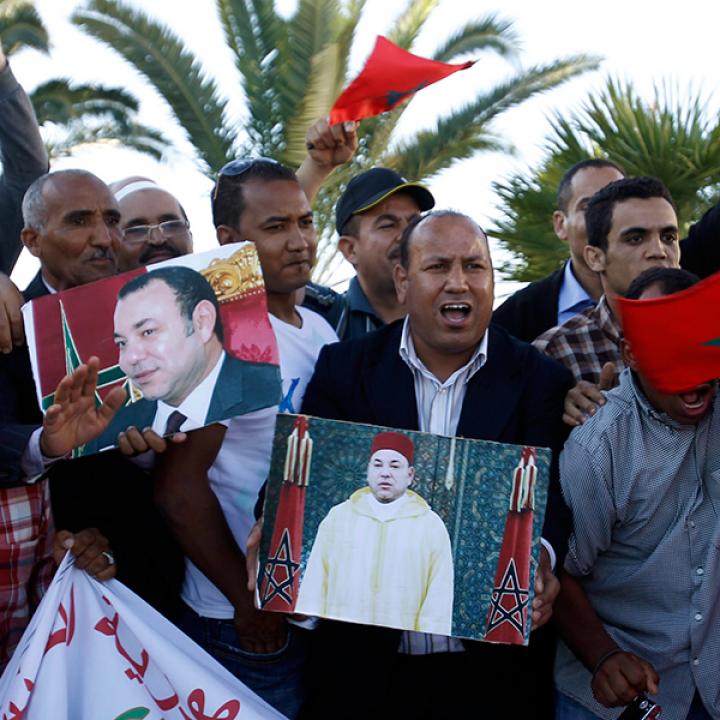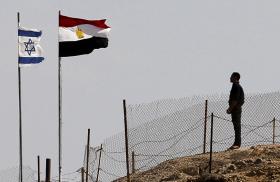
- Policy Analysis
- PolicyWatch 3155
Twenty Years Under King Mohammed VI (Part 1): Domestic Developments

America’s oldest Arab ally has made significant economic progress since 1999, but grievances regarding social issues and political reform continue to pose a challenge.
This PolicyWatch is the first in a two-part series assessing key developments during King Mohammed’s reign to date. Read Part 2, which examines foreign policy issues.
On July 30, Morocco’s fifty-five-year-old ruler Mohammed VI will commemorate twenty years on the throne. In 1999, he inherited a kingdom of twenty-eight million citizens facing considerable socioeconomic challenges, including a lack of basic necessities in rural areas, high poverty, a labor market and GDP too reliant on agriculture, and unemployment hovering around 14% nationally and nearly double that among youths. Moreover, his father’s four-decade reign had been marked by severe political repression and human rights abuses, albeit capped by a controlled opening of the political system and civil society shortly before succession.
In the twenty years since then, Morocco has made significant strides in several areas of economic and human development. At the same time, Mohammed has largely adopted his father’s preference for limited political openings, eschewing the deeper liberalization many hoped he would introduce. In the coming decades, Morocco’s ability to remain a stable exception to the chaotic regional rule will likely depend on the viability of this implied bargain.
SCHOOLS, SOLAR PANELS, AND SUFIS
Mohammed’s scorecard includes a number of noteworthy economic achievements. Morocco’s GDP rose from $42 billion in 1999 to $110 billion by 2017 (in 2017 U.S. dollars); economic growth, while still beholden to variable weather effects on agriculture, has averaged 3-4% annually, with the IMF recently predicting an improved economic outlook in the medium term; and the country now ranks second in the region after the United Arab Emirates on the World Bank’s Ease of Doing Business Index. Signaling a shift from his father, Mohammed invested in Morocco’s long-neglected north early on, one result of which was Tanger Med, the largest port on the Mediterranean Sea and in all of Africa.
Additional bright spots have appeared in school enrollment, women’s advancement, and poverty reduction. In 1999, fully one-third of primary-age children were not attending school. Following a series of reforms, primary school enrollment now stands at 97%, with the biggest gains among young girls. In 2004, the monarchy reformed the code of family law (mudawanna), granting women the rights to divorce, child custody, and self-guardianship while raising the minimum marriage age to eighteen. Poverty has fallen substantially since 1999, when roughly 16% of the population and 30% of rural inhabitants were living at or below the poverty line; today those figures are 4% and 19%. Notwithstanding their higher poverty rates, nearly 100% of rural communities now have access to electricity, compared to only 18% in 1999.
Following the push toward mass electrification, Morocco embarked on a major renewable energy development project, partly to reduce its reliance on hydrocarbon imports and partly to mitigate the adverse effects of climate change. One result has been the development of the Noor solar power plant, the largest such complex in the world and one that could ultimately make Morocco an energy exporter to Europe and Africa.
The kingdom is also a regional outlier in its approach to countering Islamist extremism. Four years into Mohammed’s reign, Morocco was rocked by the worst terrorist attack in its history, with twelve suicide bombers blowing themselves up at various tourist and Jewish sites in the capital, killing thirty-three civilians. The attack prompted the king—who as “Commander of the Faithful” is also the country’s chief religious authority—to launch comprehensive reforms such as bringing mosques and Islamic schools under tighter state control, stripping religious education curricula of extremist content, promoting Sufism and other streams of Islam believed to promote moderation, and establishing an imam training academy for students from North and West Africa and, increasingly, Europe.
These reforms have not immunized the kingdom from homegrown extremism, as attested by the estimated 2,000 Moroccans who joined the Islamic State and other jihadist groups in Syria between 2012 and 2016. Still, through a blend of heightened security measures and religious reforms, the country has evidently contained the threat of extremism better than most of its regional peers.
GRADUALISM OR GRIDLOCK?
If the Casablanca attack fueled a push to counter religious extremism, it also slowed the momentum toward political liberalization implied in Mohammed’s pledge to rule differently than his father had. After a series of early initiatives distributed approximately $185 million to over 16,000 victims of King Hassan II’s so-called “Years of Lead,” many expected civil liberties to expand under his son. But the 2003 bombings spurred a sweeping antiterrorism law that human rights groups condemned for enshrining an overly broad definition of terrorism and enabling the government to obstruct ostensibly peaceful political activity. Today, press freedom and other civil liberties remain restricted, and Morocco’s Freedom House ranking of “partly free” hasn’t budged in twenty years.
Frustration with the pace of reforms boiled over in 2011, against the backdrop of “Arab Spring” uprisings throughout the Middle East. In response to nationwide protests demanding greater political rights and an end to corruption and high unemployment, Mohammed organized a constitutional referendum and called for new elections. The main results of these initiatives were partial empowerment of the legislative branch, formal recognition of minority ethnic identities, and a new parliament dominated by the Justice and Development Party (PJD). This mildly Islamist party, with roots in the Muslim Brotherhood, had been active in Morocco’s political landscape for decades and had long since dropped its formal opposition to the monarchy. (The country’s other main Islamist organization, al-Adl wal-Ihsan, advocates eliminating the monarchy and is thus banned.)
At the same time, the 2011 constitution reserved considerable powers for the king, and his allies have since built new parties to counteract the PJD. The resulting dynamic largely reproduced the contours of a political system long familiar to Moroccans: a monarchy unwilling to cede much power governs alongside (or, rather, above) political parties that are unable to advance shared legislative goals. A decentralization program was initiated to grant more discretion and responsibility to regional governments, but the process has largely stalled. Meanwhile, corruption remains rampant; youth unemployment, a driving factor behind the 2011 protests, stands at 22% nationally and 43% in urban areas, a sobering figure given that nearly half of Morocco’s 34 million citizens are under age twenty-four; economic inequality, as reflected in annual measures of Morocco’s Gini coefficient, remains at pre-1999 levels or worse; and access to decent healthcare and education is limited.
Such conditions fueled a series of protest movements in the years following Morocco’s “Spring.” In 2016-2017, mass demonstrations broke out in the traditionally restive Rif region after a local fishmonger was crushed to death by a garbage truck as he sought to retrieve his confiscated catch. More than 150 protestors were arrested in the ensuing crackdown on the al-Hirak al-Shaabi movement, whose leaders are currently serving twenty-year jail sentences. In 2018, an unprecedented boycott targeted three of the kingdom’s leading companies in protest of longstanding links between business and political elites. Notably, two of the companies are run by individuals with known ties to the palace.
According to the latest Arab Barometer poll, 49% of Moroccans want rapid domestic change (the highest percentage of any Arab country polled), and 70% of adults under age thirty wish to emigrate. Adequately addressing the frustrations behind such figures will be a central challenge for Mohammed as he enters his third decade of rule.
CONSIDERATIONS FOR WASHINGTON
The United States has a clear interest in helping Morocco preserve its relative stability, particularly given the uncertainties gripping Algeria next door. That stability largely depends on Rabat’s ability to continue implementing reforms in a way that reduces the drivers of social unrest while avoiding the chaos and authoritarian regression seen elsewhere in the region. Washington can boost the kingdom’s chances of success by more actively engaging it in the development arena.
Targeted U.S. assistance has already yielded substantial results under Mohammed VI. For example, a five-year Millennium Challenge Corporation grant of $697 million in 2008-2013 reportedly facilitated Morocco’s poverty reduction efforts. A second MCC “compact” of $450 million went into effect in 2017, rightly targeting job creation and land productivity. But the Trump administration has repeatedly sought to reduce its annual aid package, perhaps reasoning that Morocco’s relative calm obviates the need for assistance. Given the kingdom’s ongoing economic woes and growing indicators of social frustration, the administration should reconsider this stance.
One area that warrants greater attention—and to which Rabat would be especially receptive—is investment in Morocco’s private sector. Specifically, the Trump administration should consider creating a Moroccan-American Enterprise Fund, based on the highly successful model established by previous administrations with various Eastern European allies. Such a fund would spur much-needed private-sector growth in the kingdom and could even create opportunities for joint business ventures with American firms.
Of course, any engagement with Morocco will be hampered to the extent that Washington’s diplomatic presence remains limited. Accordingly, sending an ambassador to Rabat remains an urgent priority.
Sarah Feuer is an associate fellow with The Washington Institute, where Reda Ayadi was a research assistant from 2018 to 2019.



